High Performance Management Practices and Sustainability Outcomes within Higher Education Institutions
Abstract
As a condition for a successful accomplishment of TQM (Total Quality Management), strategy within the higher education institutions is the presence of a contemporary management especially a strong leadership. In this paper the effort to develop a universal, integral methodology for designing and implementing TQM system for higher education. The model - methodology that is implied is integral and universal, meaning that it’s applicable to all higher educational institutions regardless of their nature, and the success of its usage will depend only if the integration with the informative technology is achieved together with the following: internal standardization, methods and techniques for quality improvement, system for costs analyses etc., but all of these along with continuing education and motivation of the employees. The integral methodology for designing and implementing the TQM system has a reflective contact as an outcome from the necessity of the permanent promoting of the education processes. Repetition or even a spiral one of such cycles could enable to see the assets of the usage of them thus the organization attitude towards those initiatives is being changed and depicts stimulation towards higher aims of perfection. This methodology would present a success into the implementation for improvement of the educational processes into Macedonian institution of higher education.
Keywords: TQM systemmethodologystandardizationmethods and techniques for qualitysystem for costs analyseseducation
1.Introduction
Globalization enables providing “European” space of the higher education in order to allocate a
mutual conception of competence and increased mobility of the students and the academic staff as well
(Sursock et al., 2010).
Therefore, Europe has become the crossing point in the higher education, with already set
regulations and principles for common collaboration and usage of mutual outcomes.
Through the National Strategy for Development of Education in Macedonia the tendency of the
state to conduct reforms in the education that would enable compatibility in the study programs,
recognition of the diplomas acquired to all educational degrees in each part of Europe and increased
capability for employment within the European labor market, has being offered.
The system structure for providing quality into the institutions of higher education comprehends
with the regulation even though there is a huge gap between the quality management and the attitude of
performing quality. Higher education institutions are aware of the necessity of redesigning the study
programs profiles and the curricula quality would be depending from the obligation to reassess values,
whether the study environment is tempting and etc., which all depends of the institutional leadership.
2.Literature review
TQM philosophy has been accepted in many higher educational institutions worldwide, and its
usage refers to new key adjustments into the quality approach within the educational process (Ramsden,
1991; Smith, 1995;Sohail & Rajadurai, 2006; Thomas, 2002). The very first alteration refers to the
establishing of processes of continuing improvement in all segments of higher educational institutions by
involving of the academic staff, and the second by gratification of the needs to all users (students,
teachers, Ministry of Education and Science, employments and professional bodies, the society as a
whole and the international forum) together with the outcomes of the institution (Reay et al., 2010;
Mitreva et al., 2016b).
2.1 What’s the core of TQM strategy?
As of the interpretation that has been provided by the European Foundation for Quality
Management (Model, 2003) the significance of the total quality management (TQM) is defined as it
follows: “Management strategy for flawless achievement of an institution and its outcomes” (Young Kim
et al., 2010; Wongrassamee et al., 2003).
The Ministry of Education and Science of Republic of Macedonia (Cepujnoska et al., 2004)
carries out its own gauge for quality efficiency within the higher education and it is usually expressed in
the following manner: number of students that are completing the study programme on time with an
international recognition.
The quality itself within the higher education is being accomplished through many activities as
part of the education and research and includes all the factors: students and teachers (the human factor),
educational technology, methods for quality assessment, equipment, premises, management, and finance,
motivation and labor market (Kivistö, 2005; Harung, 1996; Frenk et al., 2010). As for that, the quality is
being evaluated through a system for providing quality within an educational institution (Mitreva &
Filiposki, 2012a; Mitreva et al., 2016a; Mitreva, 2012b).
2.2Factors for Successful Implementation of TQM Strategy within Higher
2.1.1 Education Institutions
As a condition for a successful accomplishment of the TQM strategy within the higher education
institutions is the presence of a contemporary management especially a strong leadership (Ciampa, 2005).
The leadership includes an initiative that comes from the top executives, consent of the academic staff,
break-through of opinions, proactive working style, teamwork, training, and support during successful
actions and achievements (Mitreva, 2009).
Expansion of TQM concept within the higher institutions seeks a solid social and cultural level of
the environment (habits and mentality of the employees), creating an infrastructure and development of a
corporative attitude into those institutions (Ishikawa, 1995; Essenko & Rothmann, 2007; Altbach &
Knight, 2007; Baum, Ma & Payea, 2010).
In this paper the effort to develop a universal, integral methodology for designing and
implementing TQM system for higher education through TQM principles has been presented. This
methodology is to help out and produce useful directions to all institutions of higher education that tend
to become “world’s class” institutions (Mitreva, 2011).
The model-methodology that is implied (Mitreva, 2011) is integral and universal, meaning that it’s
applicable to all higher educational institutions regardless of their nature, and the success of its usage will
depend only if the integration with the informative technology is achieved together with the following:
internal standardization, methods and techniques for quality improvement, system for costs analyses etc.,
but all of these along with continuing education and motivation of the employees.
The integral methodology for designing and implementing the TQM system has a reflective
contact as an outcome from the necessity of the permanent promoting of the education processes.
Repetition or even a spiral one of such cycles could enable to see the assets of the usage of them thus the
organization attitude towards those initiatives is being changed and depicts stimulation towards higher
aims of perfection (Mitreva, 2012b).
This methodology would present a success into the implementation for improvement of the
educational processes into Macedonian institution of higher education. It will also raise the awareness of
the academic and the administrative staff regarding quality and their tendency towards the increasing
contentment of the students and teachers, Ministry of Education and Science, employment and
professional bodies, the society as a whole and the international forum (Taskov & Mitreva, 2015). But,
without the support of the leadership and without the involvement of the academic staff, all the efforts for
improvement would be in vain (Mitreva et al., 2016a).
3.Proposal for an integral methodology for designing and implementing of TQM
systems within Macedonian institutions of higher education
The basic within the designing of such model is the redesign after which a new phase of education
-continuous improvement, cycling the Deming’s quality circle (Plan-Do-Check-Act) is followed.
The necessity of redesign/ reengineering could arouse among those institutions that are willing to
abandon the traditional approach by introduction of a new one, modern approach of education and
science. Both approaches are based on same postulates: competences, abilities and knowledge but all
those differently implemented according the technological development of the country and the higher
educational systems in it.
The integral methodology for designing and implementing the TQM system is consisted of a
number of methodologies (Mitreva, 2011): Methodology for the subsystem - internal standardization;
Methodology for subsystem- statistical process control (SPC); Methodology for analyzing total costs
within a process; Methodology for subsystem- education; Methodology for assessment of success as of
the designed and the implemented system according TQM (Figure
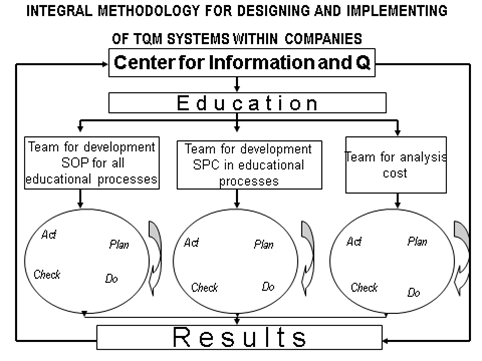
3.1.Methodology for the subsystem - internal standardization
The system for quality providing into the higher education is a whole of mechanisms, activities
and gauges that are being conducted into higher educational institutions in order to create a well-educated
cadre, fully professionally trained and responsible for work in each societal environment.
Each institution makes own system for quality providing according the curricula field that is being
cultivated and according the conditions in which this is being implemented and in the framework of the
European standards for higher education.
Each higher educational institution functions according the acts through which every step of the
curricula and the research activities have been defined. The acts are being adopted according the
necessities of the academic staff, students or the administrative wards. The acts contain the obligations
and responsibilities of each and every employee, but before all the ones regarding the senior and junior
academic staff and the students within the accomplishment of the higher educational process.
The procedure of the designing and the implementing process for internal standardization is done
through few steps, (Figure
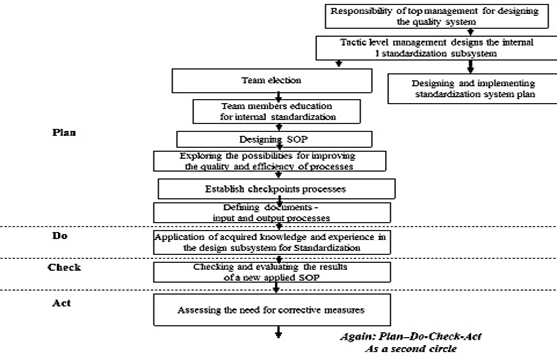
�
standardization.
�2 step: Election of team members.
�3 step: Education of the team members of the system for designing and implementation of
quality providing within higher education.
�4 step: Designing of SOP (Standard Operative Procedures) according the actual condition into
the higher educational institution through preparation of a number of documents that will be
useful to the employees in the higher education, the students and the society.
The best way to depict the SOP with a block diagram in which every phase of the educational
process will be marked, then the people that perform the activities as well as the incoming and outgoing
documentation. In this way each lack can be seen and therefore able to react immediately into the
eliminating them. The block diagram is the most simple and most practical manner of describing the
business process.
�5 step: Examining the possibilities for improvement of quality and efficiency of the
processes.
�6 step: Establishing the control points of the processes where the data could be collected.
�7 step: Defining of documents – incoming and outgoing in each process.
�
designed subsystem for standardization?
The processes ought to be done in accordance with the provided conditions and well planned
optimal exploitation of all resources. The check-up (evaluation) is organized inside the institution (self-
evaluation) and out of the institution by the Evaluation Agency.
�
�
The Commission for self-evaluation is appointed to make a critical analyzing of the institution, to
submit a report to the management board and then in a role of monitoring request an implementation of
its their own suggestions and remarks into the problem-solving of the failures meaning to remove the
obstacles into providing the planned quality.
After adopting four of the given activities in the circle of qualities they need to be used in practice
though continuously. That refers to the adopting of standards, SOP and normative for all processes into
the higher education and research by which the levels of possible measuring and achievement will be
described.
The very first circle for providing quality is the hardest and most durable because it is linked with
building the infrastructure, creating legislation, academic training for conduction of self-evaluation and
external evaluation processes in a lack of professional experience towards that (Mitreva & Filiposki,
2012a).
3.2.Methodology of the sub-system- statistical process control (SPC)
Measuring quality into the educational process is done by using adequate methods and techniques
by which data collecting of the current condition is being provided. According the data and information
the bases level of the work indicator is being evaluated and selecting of the problems that demand a
special attention.
The identifying of the fundamental problems causers for quality providing can be done thought the
analyses (data checkups, implementing special methods and techniques for data analysing etc.).
The procedure for establishing the subsystem for statistical process control is done through the
following activities, (Figure
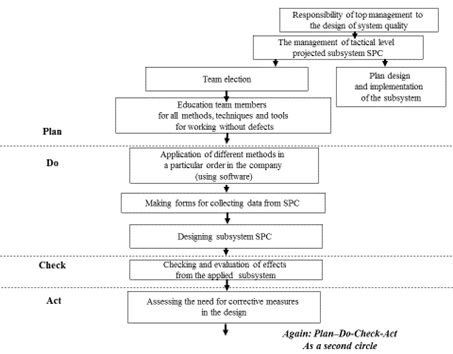
�
step: Team member’s selection.
step: Training of the team members on the methods and techniques for
providing quality.
�
and established aim into the higher educational institution.
The usage of the software packages as a fast and easy to use is even more emphasized.
�5 step: Preparation of forms for SPC data collection.
�6 step: Designing a subsystem for SPC within a higher educational institution.
Within the subsystem for SPC managing in an institution the following ought to be defined:
what needs to be controlled;
where will the outcomes be collected, filed and analyzed;
persons appointed for collecting, filing and analyzing of results;
manner of presentation of outcomes,
the path of the outcomes;
establishing and realization of policies for quality check-up;
preparation, operationalizing and realization of the plan and programme for quality check-up;
determining and realization of the manner, procedure and the means for quality control in education.
�
�
designed SPC subsystem.
And the circle starts spinning again.
3.3.Methodology for analyzing of total costs in a given process
Management with total amount of costs is done in few steps, (Figure
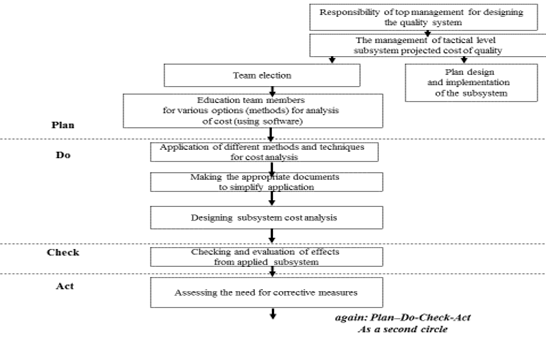
�
�2 step: Selection of team members.
�3 step: Establishing teams and their education for different possibilities (methods) for costs
analyses.
Often, the software solutions for optimization of educational processes meaning a work
performance with least costs are used.
�
a higher educational institution.
�5 step: Preparation of a proper documentation for a simplified usage of methods for costs
analyses.
�6 step: Designing a subsystem for cost analyses.
�
�Analysis of the outcomes is done with a revision of the starting relation of the costs of adjustment
and discrepancy in the business process.
�(
3.4.Methodology of the subsystem- education
The system for providing TQM should not only be well designed but it is necessary to be solidly
implemented into practice. Therefore, it is necessary to follow a continuous education, training of
management board and well as the academic staff, training of the students and the administrative staff,
through which the system for providing quality and its maintenance will be strengthening.
Planning the educational process is a task for the top management dulled to establish an education
ward. This ward would have to prepare the plans and programmes in different levels for providing
quality, in accordance with the functions and tasks that are being realized into an institution of higher
education using the methodology and usage of Deming’s circle of quality.
The education of the employees into the whole structure of the higher educational institution is
aiming to gain skills and experience into the realization of the educational processes. It is in accordance
with the quality demands of the educational process, legal responsibilities and adequacy criteria as well as
appointing the academic staff because the quality demands an involvement of each (everyone with their
own work obligations).
The educational process needs to be done through a usage of a quality circle in few steps:
In the planning phase, it is necessary to make the following steps, (Figure
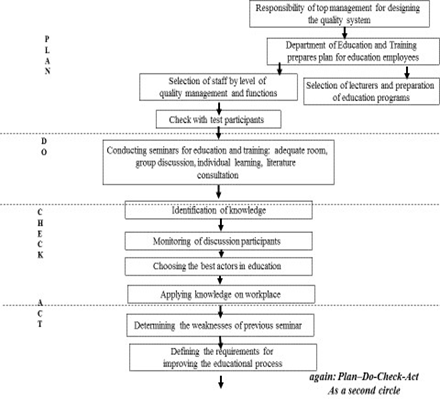
�
staff.
�2 step: Election of teaching staff (experts, specialists) from the employees or
externally in order to realize the training.
�3 step: Election of participants in the training- employees from different sectors
and schools/ departments.
�
�
�
As with the new amendments, the second quality circle begins (Plan-Do-Check-Act).
This working mode continues spirally in direction of a constant improvement in all
functions of the work performance within a given institution of higher education.
3.5.Methodology for evaluation of the outcomes from the designed and implemented
TQM system (Audit)
The aim of the fifth phase – control, is an evaluation and monitoring of the results
from the previous phases. In this phase the modification of the system and the
establishing of new rules, procedures and instructions, as well as other norms are being
verified.
The process procedure of the check-up is done through the following activities,

(Audit) within the higher educational systems
�
2 step: Election of the evaluation board.
3 step: Training of the evaluation board.
4 step: Preparation and analyzing the needs, standards and documentation that is necessary for the
assessment.
�
TQM system.
�
The results are to present: what have the higher educational institution achieved and the possibilities
present how those results have been achieved.
�
undertaking corrective measures.
The integral methodology for designing and implementing of TQM system has a feedback as a result
of the necessity of permanent improvement of the educational processes.
In order for this methodology to be efficient, it is necessary to implement an information technology.
4.Conclusion
4.1 The benefits of the proposal- methodology for designing and implementing a TQM system
into higher education institutions
The benefits from the methodology for designing and implementing the TQM system into higher
education institutions are:
•by the usage of the internal standardization the responsibility of the academic and
administrative staff improves during the accomplishment of the educational processes;
•With the usage the statistical methods and techniques of quality in education is
provided;
•with the usage of the software packages the efficiency of the usage of statistical
methods and techniques is being increased;
•through the analyses of costs for quality the loss can be easily controlled and therefore
be reduced to minimum.
Without a dedication of the top management towards the set goals for quality of the educational
process and consistency within its implementation, all those efforts will be just a simple waste of money
and time which will at the same time reduce the possibility for success into a following initiative of such
type. The leadership includes an initiative that comes from the top executives, consent of the academic
staff, break-through of opinions, proactive working style, teamwork, training, and support during
successful actions and achievements.
It should be emphasized that the benefits from the introduction of this model cannot be
immediately seen as it takes more time. But this oughtn’t to be a reason to give up the starting initiative
because the quality is a long-term process (Kano, 1996; Yang, 2009).
The assets of the usage of such model is not only an increase of the dedication from the top
management and the academic staff towards the improvement of the educational processes but achieving
a contentment of students, parents, teachers and the society which will further on serve as a moving
power for continuous improvements (Taskov & Mitreva, 2015; Tabellini, 2010).
Yet, the conclusion remains that there is a clear determination of the Macedonian higher
educational institutions regarding the care and the responsibility to provide and promote the quality in
education and as a result the interest for cooperation among the universities in the country and Europe has
increased as well.
References
- Altbach, P. G., & Knight, J. (2007). The internationalization of higher education: Motivations and
- realities. Journal of studies in international education, 11(3-4), 290-305.
- Baum, S., Ma, J., & Payea, K. (2010). Education Pays, 2010: The Benefits of Higher Education for Individuals and Society. Trends in Higher Education Series. College Board Advocacy & Policy Center.
- Cepujnoska, V., Baumgartl, B., Donevski, B., & Fried, J. (2004). Quality Assurance In Higher Education: From Analyses To Improvement. In Guidelines For Macedonia With a View to Current Practices In Europe. Skopje: Interuniversity Conference of Republic of Macedonia.
- Ciampa, D. (2005). Almost ready: how leaders move up. Harvard business review, 83(1), 46-53.
- Essenko, N., & Rothmann, S. (2007). Job characteristics, optimism, burnout, and ill health of support staff in a higher education institution in South Africa. South African journal of psychology, 37(1), 135-152.
- Frenk, J., Chen, L., Bhutta, Z. A., Cohen, J., Crisp, N., Evans, T., & Kistnasamy, B. (2010). Health professionals for a new century: transforming education to strengthen health systems in an interdependent world. The lancet, 376(9756), 1923-1958.
- Harung, H. S. (1996). A world-leading learning organization: A case study of Tomra Systems, Oslo, Norway. The Learning Organization, 3(4), 22-34.
- Ishikawa, K. (1995). President Touka Henkau Sozo Gakkai,“. Thoughts on risk management “Creativity and risk management”, JUSE, Societas Qualitatis, 9(3), 5.
- Kano, N. (1996). Business Strategies for the 21 sr Century and Attractive Quality Creation. ICQ, Yokohama, 105.
- Kivistö, J. (2005). The government-higher education institution relationship: Theoretical considerations from the perspective of agency theory. Tertiary Education and Management,11(1), 1-17.
- Mitreva, E. (2009). Methodology for improvement of business processes. Central and Eastern European Online Library,3(3), 177-190.
- Mitreva, E. (2011). Model-integral methodology for successful designing and implementing of TQM system in Macedonian companies. International Journal for Quality Research, 5(4), 255-260.
- Mitreva, E. (2012b). Methodology for designing an educational subsystem as a poll from the house of quality in Macedonian companies. Problems of Management in the 21st Century, 3(3), 81-90.
- Mitreva, E., & Filiposki, O. (2012a). Proposal methodology of the subsystem-internal standardization as part of TQM system. International Journal for Quality Research, 6(3), 251-258.
- Mitreva, E., Nikolov, E., & Nikolova, B. (2016b). Application of Total Quality Management (TQM) in the Macedonian Railways Transport in the Republic of Macedonia. Calitatea, 17(151), 55.
- Mitreva, E., Taskov, N., Milos, P., & Gjorshevski, H. (2016a). Measuring the quality of the high education in the Republic of Macedonia. IIASS-Innovative Issues and Approaches in Social Sciences, 9(1), 163-180.
- Model, E. E. (2003). European foundation for quality management. Brussels (Belgium).
- Ramsden, P. (1991). A performance indicator of teaching quality in higher education: The Course Experience Questionnaire. Studies in higher education, 16(2), 129-150.
- Reay, D., Crozier, G., & Clayton, J. (2010). ‘Fitting in’or ‘standing out’: Working�class students in UK higher education. British Educational Research Journal, 36(1), 107-124.
- Smith, J. A. (1995). The use of quality function deployment to help adopt a total quality strategy. Total
- Quality Management, 6(1), 35-44.
- Sohail, M. S., Daud, S., & Rajadurai, J. (2006). Restructuring a higher education institution: A case study from a developing country. The International Journal of Educational Management, 20(4), 279-290 Sursock, A., Smidt, H., & Davies, H. (2010). Trends 2010: A decade of change in European Higher Education (Vol. 1). Brussels: European University Association.
- Tabellini, G. (2010). Culture and institutions: economic development in the regions of Europe. Journal of the European Economic Association, 8(4), 677-716.
- Taskov, N., & Mitreva, E. (2015). The motivation and the efficient communication both are the essential pillar within the building of the TQM (total quality management) system within the Macedonian Higher Education Institutions. Procedia-Social and Behavioral Sciences, 180, 227-234.
- Thomas, L. (2002). Student retention in higher education: the role of institutional habitus. Journal of Education Policy, 17(4), 423-442 Wongrassamee, S., Simmons, J. E. L., & Gardiner, P. D. (2003). Performance measurement tools: the Balanced Scorecard and the EFQM Excellence Model. Measuring business excellence, 7(1), 14-29.
- Yang, C. C. (2009). Development of an integrated model of a business excellence system. Total Quality Management, 20(9), 931-944.
- Young Kim, D., Kumar, V., & Murphy, S. A. (2010). European foundation for quality management business excellence model: an integrative review and research agenda. International Journal of Quality & Reliability Management, 27(6), 684-701.
Copyright information

This work is licensed under a Creative Commons Attribution-NonCommercial-NoDerivatives 4.0 International License.
About this article
Publication Date
25 May 2017
Article Doi
eBook ISBN
978-1-80296-022-8
Publisher
Future Academy
Volume
23
Print ISBN (optional)
-
Edition Number
1st Edition
Pages
1-2032
Subjects
Educational strategies, educational policy, organization of education, management of education, teacher, teacher training
Cite this article as:
Mitreva, E., Taskov, N., & Gjorshevski, H. (2017). High Performance Management Practices and Sustainability Outcomes within Higher Education Institutions. In E. Soare, & C. Langa (Eds.), Education Facing Contemporary World Issues, vol 23. European Proceedings of Social and Behavioural Sciences (pp. 227-240). Future Academy. https://doi.org/10.15405/epsbs.2017.05.02.30

